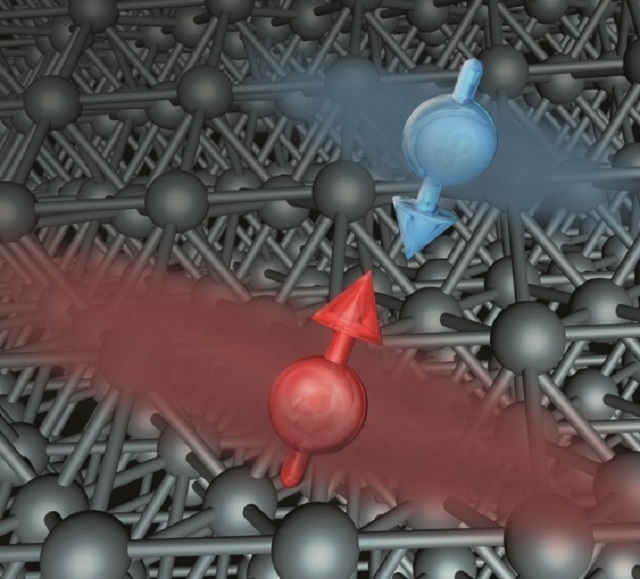 Difference in conduction by electrons with opposite spins in ferromagnetic metals can be precisely resolved using terahertz waves. (Credit: MPI-P)
Difference in conduction by electrons with opposite spins in ferromagnetic metals can be precisely resolved using terahertz waves. (Credit: MPI-P)
Researchers at the Max Planck Institute for Polymer Research (MPI-P) and the Johannes Gutenberg University (JGU) have developed a new ultrafast terahertz spectroscopy that yields direct insight into the building block of modern magnetic memories.
A huge amount of information can be stored in the existing magnetic memories including hard drives that can be found in nearly every computer. This is due to the presence of small, nanoscale magnetic sensors called spin-valves that support memory readout. These spin-valves operate based on the giant magnetoresistance (GMR) effect developed by Albert Fert and Peter Grünberg, who were awarded with a Nobel Prize in Physics in 2007.
The GMR effect is derived from Sir Nevill F. Mott’s principles of electrical conduction in ferromagnetic metals, proposed in 1936. According to Mott, the scattering of the conduction electrons in ferromagnetic metals is based on the electron’s microscopic magnetic moment, called the spin. This means that electrons with single spin orientation have a less scattering effect, and hence, more conductive than the electrons with reverse spin orientation. The amplification of spin-asymmetry in electron conduction is achieved on combining the thin films of ferromagnetic and nonmagnetic metals to produce a spin-valve. When the electrical resistivity of the spin-valve becomes responsive to the magnetic field, a GMR effect is produced.
Despite its significance in magnetic memories and several other technologies, the Mott spin-dependent conductivity is quite difficult to observe directly. In fact, it is possible to directly and unambiguously determine the basic factors of Mott conduction such as spin-dependent electron scattering time and spin-dependent electron density only if the measurement of the metal conductivity is on the same ultrafast timescale at which electron scattering takes place (i.e. sub-100fs). This shows that the need for the ultrafast timescale of measurement has prevented the fundamental magnetotransport observation in metals for a long time.
The new research has overcome the long time challenge with the introduction of ultrafast terahertz spectroscopy (1THz = 1012Hz, i.e. one thousand billion oscillations per second).
By studying the interaction of THz electromagnetic waves - which oscillate about as fast as the electrons in metal scatter their momentum - with a spin-valve, we could directly measure for the first time the fundamental parameters of Mott conduction. In particular, we found that the traditional measurements performed on the slower timescales significantly underestimate the spin-asymmetry in electron scattering which is responsible for the magnetic sensor operation.
Dmitry Turchinovich, project leader at the MPI-P.
The research team led by Dmitry Turchinovich (MPI-P) and Mathias Kläui (JGU) included Zuanming Jin, Alexander Tkach, Frederick Casper, Victor Spetter, Hubert Grimm, Andy Thomas, Tobias Kampfrath, and Mischa Bonn.
The research work was contributed by the Fritz Haber Institute of the Max Planck Society and Sensitec GmbH. This work delivers an innovative and versatile solution, ultrafast THz spectroscopy for spintronics investigations, paving way for a new research platform called terahertz spintronics.
The findings of the work were published in the Nature Physics journal.
References